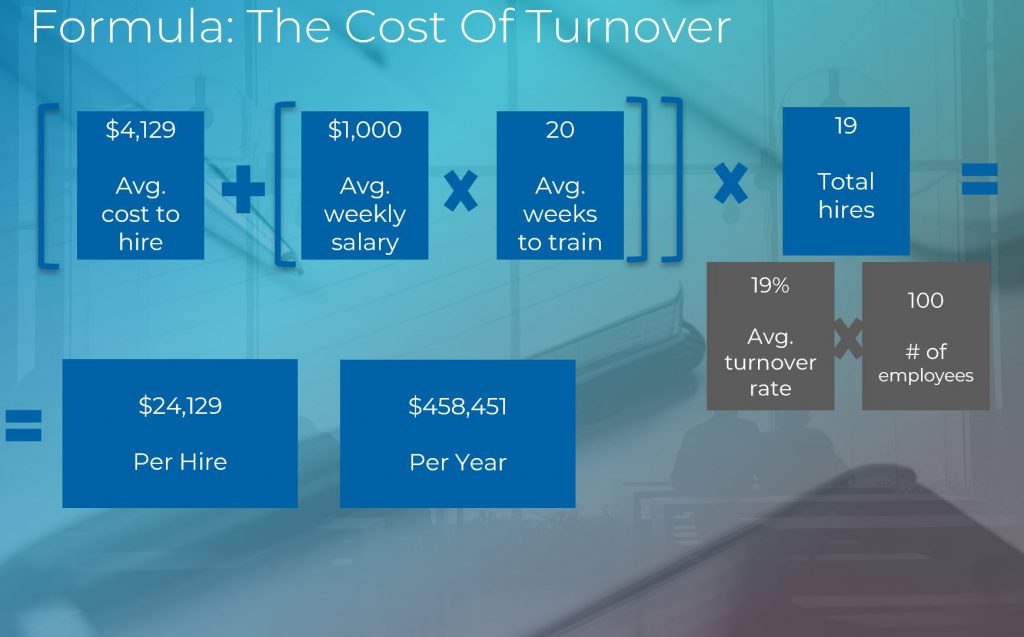If you’re thinking “I was told there would be no math,” please keep reading and know that you can partner up with us to get an accurate cost of turnover for your organization. If analyzing the data isn’t a strength of yours, we can help clarify it for you and make it simple.
Do you know what turnover is costing your organization?
We are going to share a formula that can help you easily see what turnover is costing you. If you don’t know all the variables, you can input industry averages to give you a ballpark. However, as we speak to many organizations and recruiters, we are often told that these average numbers are LOW. Sure, we could inflate these with anecdotal information or specific data from organizations we work with, but we believe the conservative numbers are still alarming enough to make you stop, think, and act according to your specific situation.
What is your company culture like?
- Are certain (or many) positions constantly vacant?
- Do you have to deal with infighting, blame, and individuals refusing to work with certain people?
- Are goals not achieved or exceeded because too much time is wasted on recruiting, interviewing, training, and peacemaking attempts?
- Are you wasting too much time on recruiting and training?
- Are employees experiencing burnout and stress due to being understaffed?
These are just some examples of challenges you may be facing that are affecting your bottom line, in addition to turnover costs itself.
Let’s define all the variables for turnover.
Average hiring cost
This includes job postings/ads, recruiting fees, and other hiring related costs to bring in a new candidate. This typically doesn’t include all the time employees spend reviewing resumes and conducting interviews. If you can’t easily determine your hiring costs, you can use the overall industry average of $4,129. However, if your particular industry (eg. Hospitality, healthcare etc.) has documented industry averages, we encourage you to use that number.
Average weekly salary
Are you hiring for entry level or executive roles or something in between? Determine the average weekly salary of your past year’s open positions to figure out this number. Another option is to determine the average salary of all your employees.
Average time to train
Do you know, on average, how long it takes to train someone before they are operating at full capacity and delivering ROI in their role? In some entry level positions, this may be a few weeks. In executive-type roles, this can be over a year. If you don’t know the average training time for your open roles, you can use the industry average of 8 weeks for clerical or 20 weeks for professional roles.
Number of new hires this year
What is your total number of new hires this year? Or, use last year’s number for a full 12-month number. If you don’t know the exact number of new hires, you can make your best guess based on the data you do know, or use the average turnover rate discussed next and multiply that by total employees.
Annual turnover rate
Annual, average turnover rate is the percentage of your workforce that leaves each year. To determine your rate, take your total number of new hires for a year divided by the total number of employees. For example, if you had 19 open positions and you have 100 employees, your turnover rate would be 19%. If your turnover rate is not easy to calculate, you can use the industry average, which is 19%.
Number of employees
This variable is only needed if you do not know your exact number of new hires and want to estimate it by multiplying total number of employees by annual turnover rate.
Let’s solve the formula.
If math isn’t your thing, I realize your eyes might be glazed over, and I know I’m lucky you’re still reading this. Let’s put the variables into the formula, using industry averages with an average company salary of $52,000, or $1,000 a week, to help you see the cost of turnover.

The cost of turnover in this example is $458,451. Each new hire costs an organization, on average, $24,129.
Does this number surprise you? Does it feel low or high? Now that you see the formula, are you wondering what you can do to reduce your turnover expenses? Now it’s your turn.
Need help populating this formula?
We’re happy to help you determine what your organization is spending on turnover. Keep in mind this is just one part of the expense. We haven’t even tried to quantify things such as: burn out of employees who cover for open positions, time spent reviewing resumes and conducting interviews, as well as time for IT & HR to onboard the new employee. So much time is invested in a new employee; don’t watch it walk out the door before you see a return on your investment.
Curious how you can proactively save on turnover costs with professional coaching?
Read Part 2 in the turnover series to identify how to be proactive rather than reactive. A small investment in your human capital can reap rewards, starting with reduced turnover costs, but multiplying to other benefits including increased engagement and results.
Contact us today to help address your turnover challenges now.
